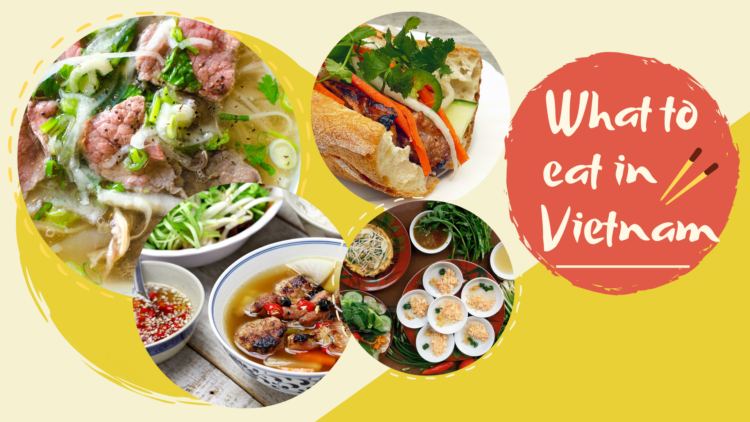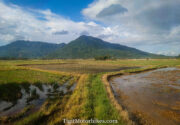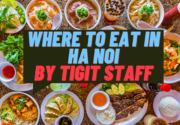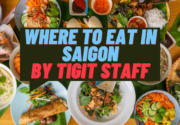You already know Vietnam is one of the greatest countries in the world for eating. This guide to Vietnamese food will help you map out your culinary choices as you ponder day after day what to eat and how it’s eaten.
Regardless if you are heading North to South, South to North or just hanging out in Danang, Ho Chi Minh or Hanoi; the Tigit guide to eating in Vietnam has you covered.
Whether you are into safe eating, typical local style eats or you are an adventurous eater; there’s a few Vietnam dining etiquette tips and some language structure too. After you read this guide you’ll be able to eat in the hole in the wall places off the highway and deep into the cities too.
This country is a veritable vacation eating paradise, there’s only one thing left to do, head out discover what to eat in Vietnam!
Contents
- Eating in Vietnam while Travelling is Super Easy
- Regional Specialties: What’s that you’re eating?
- What to Eat in The Mekong Delta
- What to Eat in Ho Chi Minh City
- What to Eat in Dalat
- What to Eat in Hoi An and Danang
- What to Eat in Hue
- What to Eat in Ninh Binh
- What to Eat in Hanoi
- What to Eat in Sapa and the Northern Highlands
- Vietnamese Desserts and Snacks
- Vietnamese Drinks
- Fruit in Vietnam
- Common Vietnamese Food Myths
- Restaurants and Eateries: What to Expect
- In the Countryside
- Finding the best spots to eat in Vietnam
- Vietnamese Eating Etiquette
- Drinking Customs
- Tips on Avoiding Sickness
- Food and Drink Vietnamese: What to say when ordering
Eating in Vietnam while Travelling is Super Easy

As you travel this country you’re not going to need to worry about being hungry for too long. Vietnamese are obsessed with food and they like it quick, easy and cheap. The cities are a hive of food stalls and restaurants.
Even outside urban areas, food will still be relatively accessible. What makes Vietnamese food even better is the variation. As you travel the country you’re going to experience dozens of regional dishes, diverse tastes, and wonderfully convenient eating.
Despite what many assume, the food in Vietnam is actually very safe to eat and few travellers get sick. Food is usually prepared by highly skilled cooks who have been preparing the same dishes for years. Rest assured they know what they’re doing otherwise they wouldn’t be in business for long.
Read ahead to get insights into the drinking culture of Vietnam, basic dining etiquette and a simple language guide too.
Also Check: average food costs in Vietnam
Regional Specialties: What’s that you’re eating?

As good as the food is here you may get bored with the similarity of some of the soups, banh mi and rice lunches. Every region in Vietnam has a special dish or snack that it’s famous for and is just begging to be sampled. Some local specialities are sometimes just a local twist on a national favourite. We’ve divided the dishes for each region based on your preference for adventure.
Many blogs advise you what NOT TO EAT but the truth is, the adventurous dishes just look strange, they are actually quite tasty. We leave it up to you to decide what you actually consume on Vietnam tables. But just in case you find yourself asking, “what’s that you’re eating?” You’ll finally know what the locals have on their plate.
The Mekong Delta |Ho Chi Minh City
Dalat and the Central Highlands |Hoi An and Danang| Hue
Ninh Binh |Hanoi |The Northern Highlands
What to Eat in The Mekong Delta
Easy Food to eat in the Mekong Delta
| Pork & coconut noodles (Banh Tam) | Thick noodle dish cooked in coconut cream |
| Grilled Elephant Ear fish (Ca tai tuong chien xu) | Grilled fish with fresh salad and rolled in rice paper |
| Pork noodle soup (Hu tieu Nam Vang) | A wholesome and super tasty pork-based noodle soup |
Pork & Coconut Noodles (Banh Tam)

Banh Tam is a deliciously salty and sweet noodle dish unique to this region. It consists of thick tapioca noodles, thinly sliced pork and shredded pig skin. Don’t let that last one turn you off. The coconut cream and dipping sauce are going to introduce you to some tasty flavours you won’t find anywhere else on your trip.
Grilled Elephant Ear Fish (Ca tai tuong chien xu)
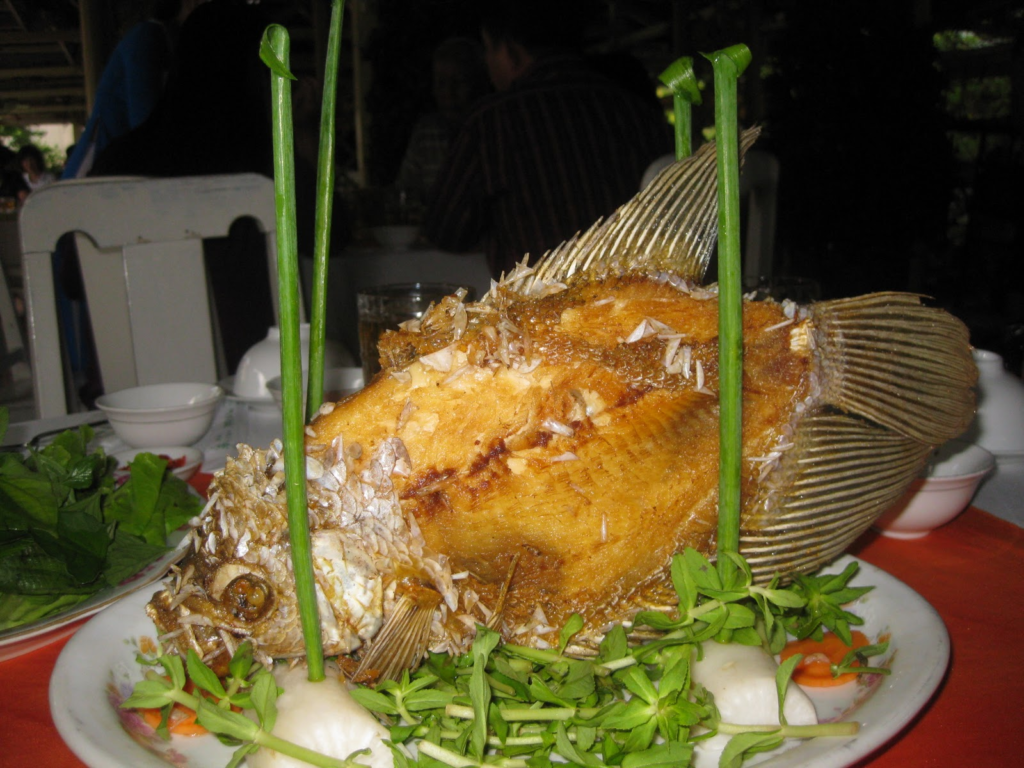
Despite what you may be thinking, this fish doesn’t have big ears and is named after it’s appearance. Most travellers to the Mekong Delta will come across this iconic dish in Can Tho or Vinh Long. It’s not a ‘fishy’ fish and most foreigners love it. This dish is shared with others and the flesh placed on rice paper with a host of herbs, it’s then rolled up and dipped in fish sauce.
Pork Noodle Soup (Hu tieu Nam Vang)
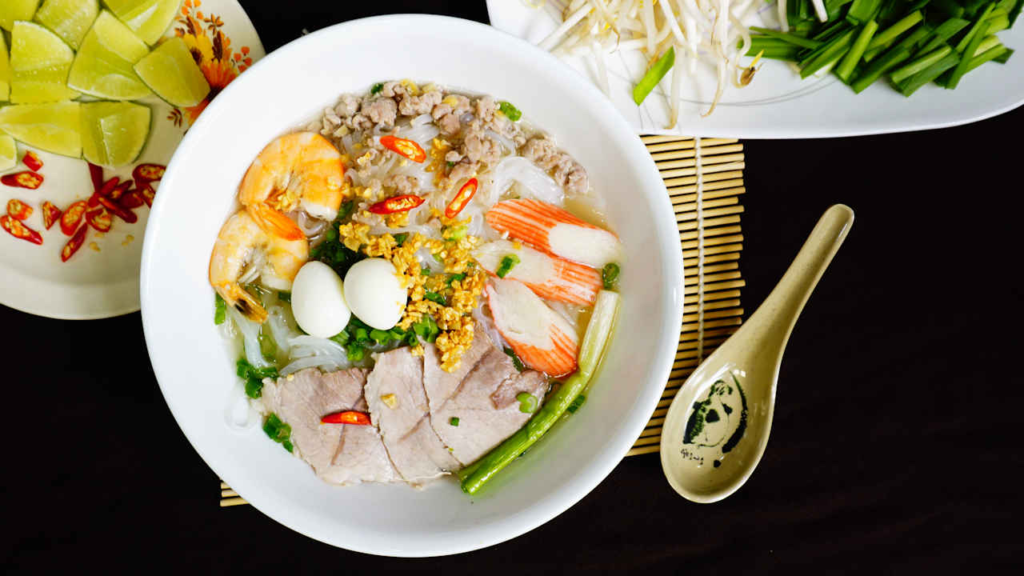
Hu tieu Nam Vang is a rich and tasty soup served in the southern parts of Vietnam and traces its roots to Cambodian and Chinese influences. Thin noodles are paired with sliced pork, a shrimp or two and some quail eggs. You might come across its popular street-food cousin, Hu tieu, which is similar but minus the shrimp and eggs.
Local Dishes in the Mekong Delta
| Field mouse (Thit chuot) | Marinated and barbecued field mouse |
| Goby hotpot (Lau ca keo) | Group hotpot with noodles, lots of vegetables and small eel-like fish. |
| Vegetables with caramelised fish sauce (Mam kho quet) | Vegetables (and sometimes meat) served with caramelized fish sauce |
Field Mouse (Thit chuot)

You’re not going to come across grilled field mouse as often as some other meat but take the chance when you do. It’s considered a delicacy and some places are dedicated to preparing them. There are several ways to cook a mouse, the most common being grilled, steamed or fried. Keep in mind that they are found in rice paddies, are much smaller and are not to be confused with the rats you see exploring city sewers.
Goby Hotpot (Lau ca keo)

This dish is another of the many dishes featuring fish and seafood which the Mekong Delta is known for. Goby fish are about two-fingers in length and look a little like an eel. The hotpot is heated in the middle of the table and a mix of local herbs and vegetables are added. The live fish are then added a few minutes before it’s ready to eat. The fish are tangy in taste and the soup rich in flavour.
Vegetables with Caramelised Fish Sauce (Mam kho quet)

This dish holds memories for many locals who lived through time of little. The dishes main ingredient is fish sauce. It is simply caramelized and prepared with small amount of fat and sugar. It is served in a small clay pot with a side of rice and vegetables and helps to make these bland foods a lot tastier. The sauce remains a favourite of southerners and these days is also served with pork and small shrimp too.
Crazy Dishes in the Mekong Delta
| Horseshoe Crab (Sam Bien Go Cong) | A freaky-looking but incredibly tasty crab |
| Snake Meat (Thit rang) | Eat the entire snake if you're game. Even the heart and blood. |
| Fried Insects (Con trung chien) | Healthy and subtle flavours combine in a crunchy and unique snack |
Tri-Spine Horseshoe Crab (Sam Bien Go Cong)

This is probably going to be one of the weirdest food you may ever come across. Go Cong is famous for its tri-spine horseshoe crab. Not only does it look like a living fossil but it also has blue blood which has enormous medicinal value. The meat is silky soft with a sweet, savoury and slightly salty taste.
Snake Meat (Thit ran)

Eating cobra is not an everyday practice and reserved only for very special occasions in any Mekong Delta province. The meat is tasty and tender though sometimes fiddly due to the lengthy rib cage. You can have it prepared and cooked in several ways just like any other meat. There are some places that offer the chance to eat the still-beating heart and down it with a shot of snakes blood. This part will be up to you I guess.
Fried Insects (Con trung chien)

Although less popular nowadays it’s still possible to get a serving and satisfy your craving for these crunchy critters. While shocking to foreigners, eating insects is somewhat normal in many parts of Asia. They’re actually low in fat, high in protein and are slowly becoming a popular and healthier alternative to meat in the west. Crickets, grasshoppers, beetles and even scorpions are on the menu here. Once cooked insects are super crunchy and a little flavourless which is why they’re always seasoned with herbs, spices and lime juice.
What to Eat in Ho Chi Minh City
Easy Food to eat in Saigon
| Broken rice (Com Tam) | Rice and pork. A staple and well-loved dish. |
| Vietnamese Baguette (Banh mi) | Pork, vegetables and herbs in a fresh bread roll |
| Beef Luk Lak (Bo luc lac) | Deliciously flavoured beef with salad and rich/chips |
Broken Rice (Com Tam)

Broken rice is popular Saigon dish with locals and a firm favourite of travellers in Vietnam. The highlight is the marinated and grilled pork chop. Served on rice beside tomato, cucumber and a portion of fish sauce, it’s a little different at each street stall. Optional extras are fried eggs, steamed egg cake, shredded pork skin and a side of soup. Eating doesn’t get much better than this.
Vietnamese Baguette with Pork/Egg (Banh mi)

The humble Banh Mi is the perfect Vietnamese street food and it doesn’t get any better than in HCMC. It can be found on street corners and storefronts at all times of day but particularly popular at breakfast time. Fillings vary but fresh baguettes are usually filled with a concoction of pate, pork, cucumber and other vegetables and herbs.
Foreigners love banh mi but if you don’t like meat then have an egg (Trung) or the vegetarian option (banh mi chay) instead. Some places even have chicken (ga). Fresh chilli (ot), chilli sauce (tuong ot) and soy sauce (Nuoc tuong) are usually added to enhance the flavours. The fresh chilli can be a little overwhelming foreign tastes. If you don’t want it simply say, “no chilli” (Khong ot).
Beef Luk Lak (Bo luc lac)

This dish has a taste that suits western palettes well and hence becomes a staple for many travellers coming to Vietnam. It consists of sauteed beef served on a bed of lettuce, tomato and cucumber. It’s usually served with a side of rice or chips and a tangy lime and pepper dipping sauce. It’s also popular in Cambodia but it’s commonly served with chips in Vietnam and with butter(bo) and salt (muoi). If you’d like some tomato ketchup (Tuong ca) either pull up a photo on your phone or ask for some “Tuong ca”.
Local Dishes in Saigon
| Frog meat (Thit Ech) | Small bones, tender meat and a subtle taste. |
| Beef wrapped in betel leaf (Bo la lot) | Juicy beef and tangy betel leaf grilled on the BBQ |
| Rice paper rolls (Goi cuon) | Quick and easy rice paper, noodle and pork spring rolls |
Frog Meat (Thit Ech)
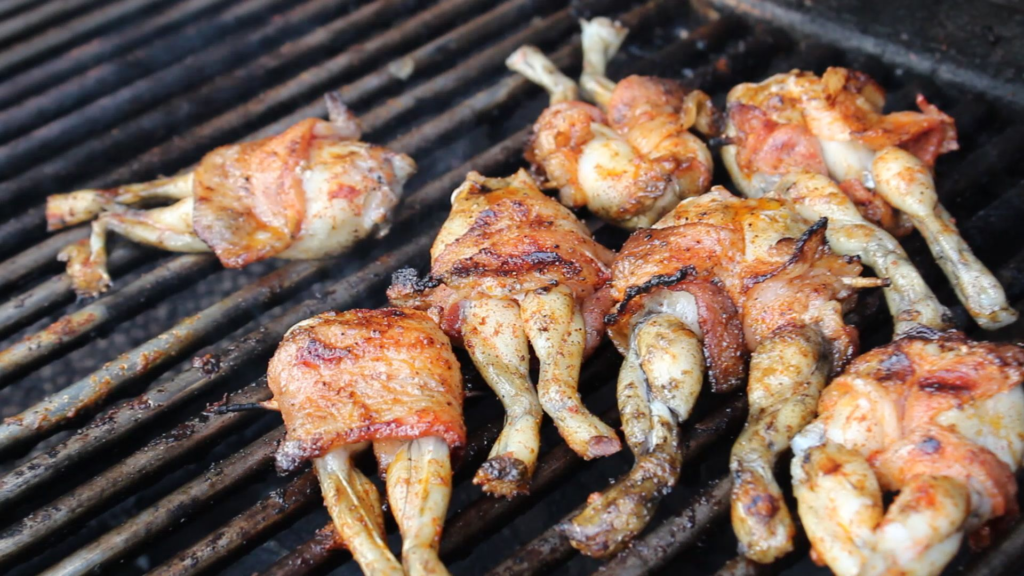
Frog isn’t as weird as it may sound at first. Without trying to sound cliche, it actually does taste a little like chicken, yet much smaller and less stringy. Fried, steamed or grilled, locals love their frog meat. Frog curry and sauteed frog are two of the more common dishes eaten with rice. It is also a popular choice as a snack or while drinking beer with friends. With many little bones the fleshy parts can be a little tricky to eat. Be patient.
Beef Wrapped in Betel Leaf (Bo la lot)

This is not your everyday beef and a classic street food dish in HCMC. Minced beef is mixed with spices, sugars and sauces before being turned into small sausages. These are then wrapped in fresh betel leaf, grilled on the bbq and served with rice paper and a stack of fresh leafy vegetables. These are rolled together dipped in special serving sauces.
Rice Paper Rolls (Goi cuon )

The fresh spring rolls which have become synonymous with Vietnamese cuisine are also a favourite of locals. They can be found at street stalls and the most expensive restaurants. Quite simple in construction they take a small amount of cold noodles, herbs, a slice of pork and shrimp. Folded together they are dipped in a rich hoisin peanut or fish sauce.
Crazy Dishes in Saigon
| Duck embryo/fetus egg (Hot vit lon) | A partially formed duck and yolk in a hard-boiled egg |
| Snails (Oc ) | Countless varieties of snails and tangy flavours |
| Beef offal stew (Pha lau bo) | Chewy innards, a flavoursome soup and a fresh baguette |
Balut/Duck fetus egg (Hot vit lon)

The infamous balut is popular and an easy-to-find snack on the street after dark. At first glance, it’s completely unassuming… until you crack open the shell. Served with salt and pepper and Vietnamese coriander they can be quite tasty. Be aware though that eggs come in different levels of development. The more developed eggs have soft bones, feathers and recognizable features of a duckling. The younger eggs are more like creamy boiled eggs.
Snails (Oc)

Snails are a social food, usually shared over a beer or two, and are a Saigon speciality. There are dozens of varieties of snails and lots of different ways to prepare and cook them. There is a process to eating them which means plucking them from the shell and dipping them in sauces. If you don’t fancy snails, the places that serve them usually have a range of shellfish and clams and other seafood.
Beef Offal Stew (Pha lau bo)

This dish is a firm favourite among locals yet avoided by almost all travellers. However, the brave are rewarded with a fragrant and tasty stew. The parts of intestines and stomach are dipped into a dipping sauce which matches the flavours well. The chewiness is probably the weirdest thing for most. A warm loaf of crusty bread used to soak up the soup makes this dish a little easier to stomach.
What to Eat in Dalat
Easy Food to Eat in Dalat
| Rice cooked in bamboo (Com lam) | Tasty rice cooked and served in a bamboo tube |
| Vietnamese baguette with meatballs (Banh mi xiu mai) | A warming treat of spicy and juicy pork or a crisp bun |
| Pork and Noodle Soup (Banh canh) | Thick noodles, veggies, pork and a tasty soup |
Rice Cooked in Bamboo (Com lam)

This simple and unique ‘dish’ is found throughout Vietnam’s mountain regions. It’s origins come from the need to somehow store the rice before setting-off for long-distance exploration. In this case, it’s quite a fitting meal for those riding through Vietnam’s mountains. After being cooked in bamboo the rice becomes much more flavoursome. It’s a particularly famous food in Buon Ma Thuot, the capital of Dak Lak province, and often served with deliciously juicy roasted chicken.
Vietnamese baguette and pork balls (Banh mi xiu mai)

Even if you think you’ve had more than enough baguettes, have one more in Dalat. As the cold night air hits the streets vendors come out with their steaming vats and fragrant pork balls. With only minimal additions, the spiced juicy pork and crunchy rolls do a good job at warming your insides.
Thick Noodle Soup (Banh canh)

Another dish great for those cold nights is particularly tasty Banh Canh. Thick handmade vermicelli swims in a broth with minced pork, sliced pork, green onions and other herbs add to that special flavour. Its thick noodles are easier to eat than others and the fatty soup is deliciously comforting.
Local Dishes in Dalat
| Rice Paper Pizza (Banh trang nuong) | A sheet of rice paper loaded up with lots of tasty goodies |
| Rice Flour Pancakes and Chicken Innards (Banh uot long ga) | Savoury pancakes served with chicken innards |
| Grilled Pork Sausage (Nem nuong) | Tasty pork sausage rolled in rice paper with vegetables |
Rice Paper Pizza (Banh trang nuong)

It’s not exactly a pizza but the shape and colours do resemble one. The thin rice paper base is spread with butter then loaded with sausage, mince or pork floss. Following this, small dried shrimp, spring onions and a quail egg or two are drizzled over as it grills over charcoal. Chilli sauce and mayonnaise are added for even more flavour. They’re usually folded over after that and eaten more like a sandwich. The best place is on the stairs above the Dalat night market!
Rice Flour Pancakes and Chicken Innards (Banh uot long ga)

This unique dish is a combination of influences but it’s only in Dalat where it is served with chicken innards. The rice flour pancakes are thin and deliciously soft. The seasoned chicken, despite it not being regular meat, it’s tasty and a good match for the pancakes. The special dipping sauce makes this dish particularly unique.
Grilled Pork Sausage (Nem nuong)

Popular with locals and travellers alike, the local pork sausage should not be missed. This meat has been infused with garlic sugar and fish sauce before it’s cured and finally grilled. It is served with leafy greens, cucumber, starfruit and other herbs. Like many other great foods in Vietnam, it is then rolled up in rice paper and dipped in a tasty sauce.
Crazy Dishes in Dalat
| Wild Meat (Thi rung) | A number of different meats that used to be found in the forest around Dalat |
| Weasel Coffee (Ca phe chon) | Rich and aromatic coffee made from beans digested by weasels |
Wild Meat

Since Dalat is surrounded by mountains and dense forests locals are accustomed to some rare meats. Deer, boar, buffalo and hedgehog are not commonplace on dinner tables but can be found at specialty restaurants. There isn’t much opportunity for hunting wild game anymore so it’s mainly left to farms to supply the demand. Wild meat is also a common specialty in Dak Lak province.
Weasel Coffee

Not only is the Central Highlands home to the Vietnamese coffee industry but it is also the best place to try weasel coffee. The reason it’s called weasel coffee is pretty straightforward. The small tree-dwelling animals love to eat coffee beans but are unable to digest them fully. As they pass through the animals they are collected, washed, roasted and ground. This process creates a unique and richer flavoured coffee.
What to Eat in Hoi An and Danang
Hoi An is a popular ancient tourist town located only a short drive from Danang City in central Vietnam. Food in Danang and Hoi An is similar but unsurprisingly there are still has some cultural differences.
Easy Food to Eat in Hoi An and Danang
| BBQ Pork Noodles (Cao lau) | The regions’ signature dish of noodles and BBQ pork |
| Chicken Rice (Com Ga) | Hoi An’s extra special chicken and rice is full of flavour |
| Turmeric Noodles (Mi Quang) | Your choice of meat over tasty egg noodles |
BBQ Pork Noodles (Cao lau)

If any dish were going to represent Hoi An this would be it. It’s comprised of large and chewy udon-like noodles. Pork slices, beansprouts, croutons and herbs are added and all are drowned in a BBQ pork sauce. Variations of this dish exist across the town and all are served with a side salad.
Chicken Rice (Com Ga)

The chicken rice is different in Hoi An. The rice is only of a certain quality rice and cooked with pandan leaves, chicken stock and turmeric. This gives it a yellow tinge and unique flavour. The chicken used must meet special criteria too. To be truly local Hoi An chicken and rice it must be from a free-range hen to ensure it’s deliciously lean and tender meat.
Tumeric Noodles (Mi Quang)
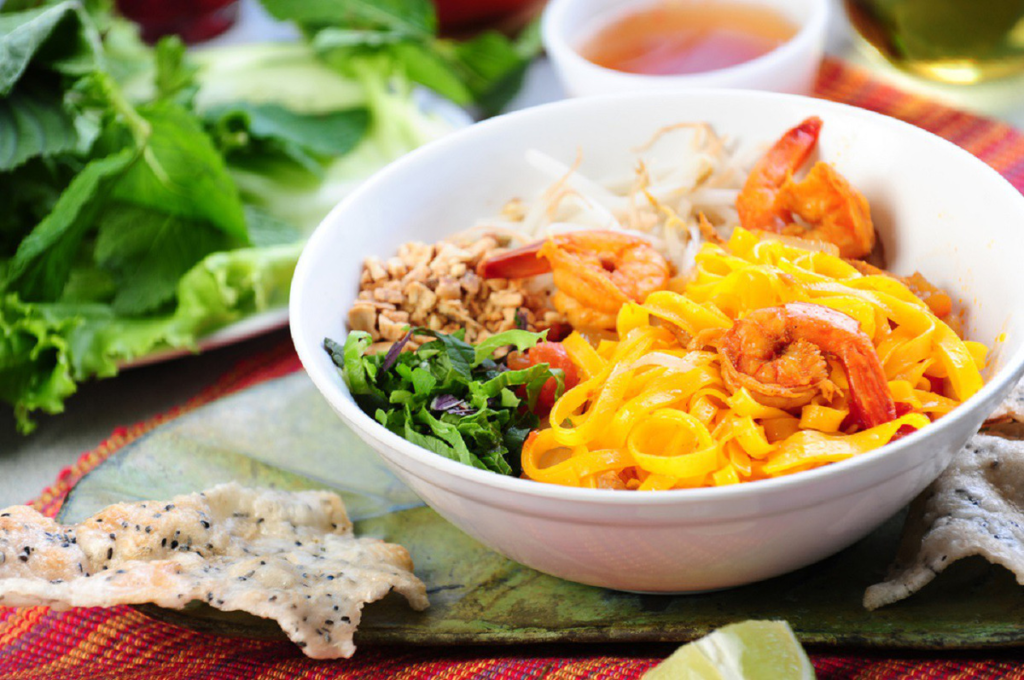
Mi Quang is similar to Cao Lao with a few key differences. Firstly, it’s made with yellow rice noodles and its broth is seasoned with fish sauce and pepper. It also has a larger range of toppings such as chicken, beef, squid, snails or even frog. Peanuts, sliced banana flowers, sesame crackers and a host of other herbs add to this dishes unique flavours.
Local Dishes in Hoi An and Danang
| Rice noodle cakes and pig offal (Bánh hỏi lòng heo) | A filling and tasty dry noodle and pork-based dish for sharing |
| Fishcake noodle soup (Bun Cha Ca) | A noodle soup full of fishy goodness and flavour |
| ‘White rose’ dumplings (Banh Bao Vac) | Delicate and oh-so-tasty dumpling |
Rice Noodle Cakes and Offal (Banh hoi long heo)

Banh hoi long heo is a well-loved and popular Vietnamese dish. It consists of super-thin rice vermicelli that forms a net-like pattern and is carefully folded . The shape and texture make them look like little noodle cakes. It’s often served with pig innards which are a good combination when paired with fresh vegetables. Simply drown in fish sauce before devouring this deliciously simple dish.
Fishcake Noodle Soup (Bun Cha Ca)

This is one noodle dish bound to keep seafood lovers happy. This Danang version is particularly special. It’s thin vermicelli noodles are matched with generous helpings of grilled fishcakes. Mackerel, barracuda or lizardfish meat is marinated, cut into pieces and grilled. Onions, beansprout and mint are added to the hearty broth creating a rich and flavoursome meal.
‘White Rose’ Dumplings (Banh Bao Vac)

An absolute Hoi An speciality! These rice dumplings come in either shrimp or pork varieties. The meat is prepared from a highly guarded secret that I’m afraid can’t be divulged on this page. They are arranged on a plate and served simply with fried onions and a tangy dipping sauce. You may hear these referred to as ‘white rose’ dumplings. This is due to their delicate nature and the way they look when arranged on the plate.
Crazy Dishes in Hoi An and Danang
| Jellyfish Salad (Goi sua ) | A cool and refreshing salad with a unique combination of ingredients |
| Chicken Feet Fried with Fish Sauce (Chan ga chien mam) | Crispy and salty makes them a perfect beer snack |
Jellyfish Salad (Goi sua)

Who doesn’t like jelly and most people can stomach some fish now and then. But jellyfish!? This local favourite may seem a little weird to most visitors to Hoi An but it’s worth a try. The jellyfish is served sitting on a bed of papaya, herbs and other vegetables. The cool and crunchy texture makes this salad particularly special.
Chicken Feet Fried with Fish Sauce (Chan ga chien mam)

No trip to Vietnam is complete without sinking your teeth into some chicken feet and these are the tastiest type. Fried in a fish sauce-based oil they maintain a salty crispiness that is unrivalled by any other snack. There isn’t a lot of meat to them and they’re mostly just skin. They’re a great snack to have with a few beers. If you’re really hungry then it’s probably best to move on to the body.
What to Eat in Hue
Easy Food to Eat in Hue
| Basket clams and rice (Com/bun Hen) | A Hue icon and seafood lovers delight |
| Beef noodle soup (Bun Bo Hue) | A widely loved and tangy beef soup in its hometown |
| Crispy pancake (Banh khoai Hue) | A savoury pancake served with meat and vegetables. |
Basket Clams and Rice (Com Hen)

While many dishes are influenced by other regions this dish is well and truly a Hue icon. Dozens of tiny clams are served on a bed of room temperature rice with a warm broth on the side. The textures and flavours found in this dish are unrivalled. Starfruit, green mango, and banana leaf are beside the dish and eaten in conjunction to enhance the meal. It also comes in a dry noodle version and can be eaten any time of day for breakfast, lunch or dinner. Con Hen Island is famous for this dish!
Beef Noodle Soup (Bun Bo Hue)

This dish is found in the farthest corners of Vietnam but nowhere does it taste like in its hometown. The noodles in Bun Bo Hue are not too thick or too thin. The rich and spicy broth is full of fragrant herbs and just enough zing. Plenty of herbs, chilli paste and lime help individualise the flavour. And those big red cubes? It’s congealed pigs blood but don’t let that turn you off as they actually taste a lot better than it sounds.
Crispy Pancake (Banh khoai Hue)

Similar to its southern cousin, Banh Xeo, Bánh khoái is a thin and crispy savoury rice flour pancake. The cake is shallow and fried in a pan before being stuffed with shrimp, pork belly, quail egg, and bean sprouts. A heap of fresh salad, figs, starfruit, cucumber and peanut sauce make this a dish to remember.
Local Dishes in Hue
| Sour shrimp paste (Mam Tom Chua) | This sour shrimp sauce is like no other |
| Steamed Rice with Lotus Leaf (Com hap la sen) | An imperial version of fried rice but with a lotus-inspired twist |
| Tapioca dumplings (Banh bot loc) | Small and chewy tapioca shrimp dumplings |
Sour Shrimp Paste (Mam Tom Chua)

Shrimp paste in Vietnam is usually ground into a thick brown or purple sauce. This sour sauce in Hue is extra special. It’s a reddy-orange colour and even though the process is quite lengthy the shrimp remains whole. Mixed with bamboo shoots, galangal, garlic and chilli it is often used in other dishes as a condiment to enhance other flavours.
Steamed Rice With Lotus Leaf (Com hap la sen)

Hue is home to the imperial city and royal families of the past. Hence, there are some extra special dishes from this era that emerge from Hue. This is one of them. The rice is firstly combined and fried with peas, carrots, small shrimp and lotus seeds. Other sauces and spices are added at this stage. It is then wrapped in a lotus leaf and steamed to permeate the insides with a subtle flavour. The dish is not only fragrant but delicious and a truly memorable meal.
Tapioca dumplings (Banh bot loc)

These small dumplings are often referred to as ‘clear cakes’ and more of a snack than a meal. Made from tapioca starch means the texture is super soft and chewy. Inside the dumpling you’ll find shrimp and pork. It’s all wrapped up in banana leaves before being steamed. It is stored in this leaf until sold. Enjoy this snack on its own or by dipping in fish sauce.
What to Eat in Ninh Binh
Easy Food to Eat in Ninh Binh
| Safe Food in Ninh Binh | Description |
| Mountain goat meat (Thit de nui) | The goat meat here is as tender as it comes |
| Crispy rice cake (Com chay) | A crispy and unique rice-based snack with additional toppings |
| Cassava vermicelli soup with eel (Mien Luon) | If you like tapioca noodles and fish then you’re going to love this soup |
Mountain goat meat (Thit de nui)
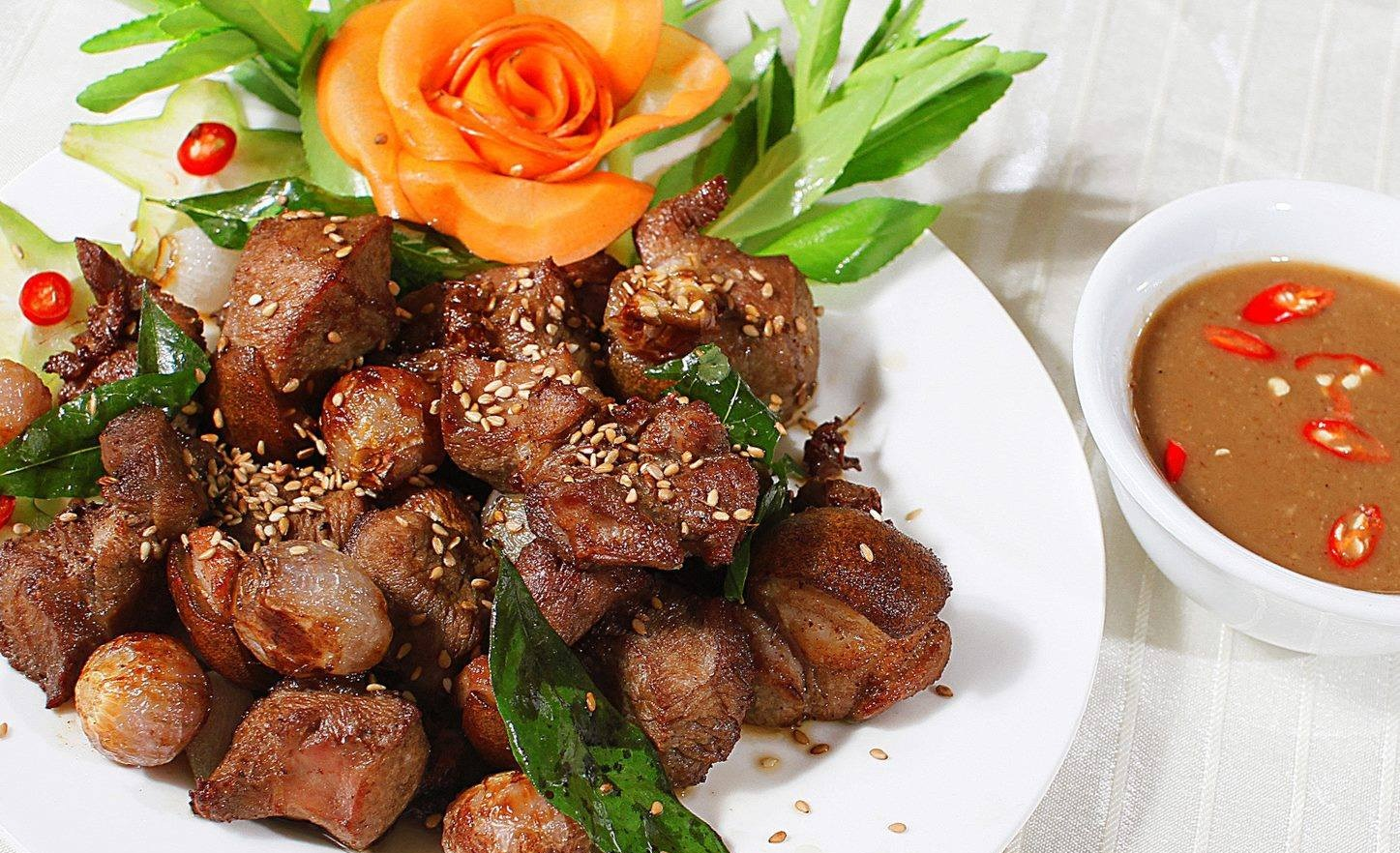
Ninh Binh goats spend their days climbing the famous karsts and hopping across the rocks. Additionally, they use different ways to prepare it which gives the meat a unique taste compared to other regions. The meat is usually stir-fried, steamed, roasted or boiled in a hot pot dish.
Crispy Rice Cake (Com chay)

While it’s a firm favourite all around the country, Ninh Binh is where the best com chay is found. It’s not a meal but a large crispy rice cake which takes a little talent to cook. A special rice variety is used to ensure extra flavour. After it’s cooked it’s laid out to dry to preserve its freshness. Once the ‘plate’ of rice has cured a mix of marinated beef, kidney, pork floss, mushrooms, spices and fish sauce is fried onto the top.
Vermicelli Noodle Soup with Eel (Mien Luon)
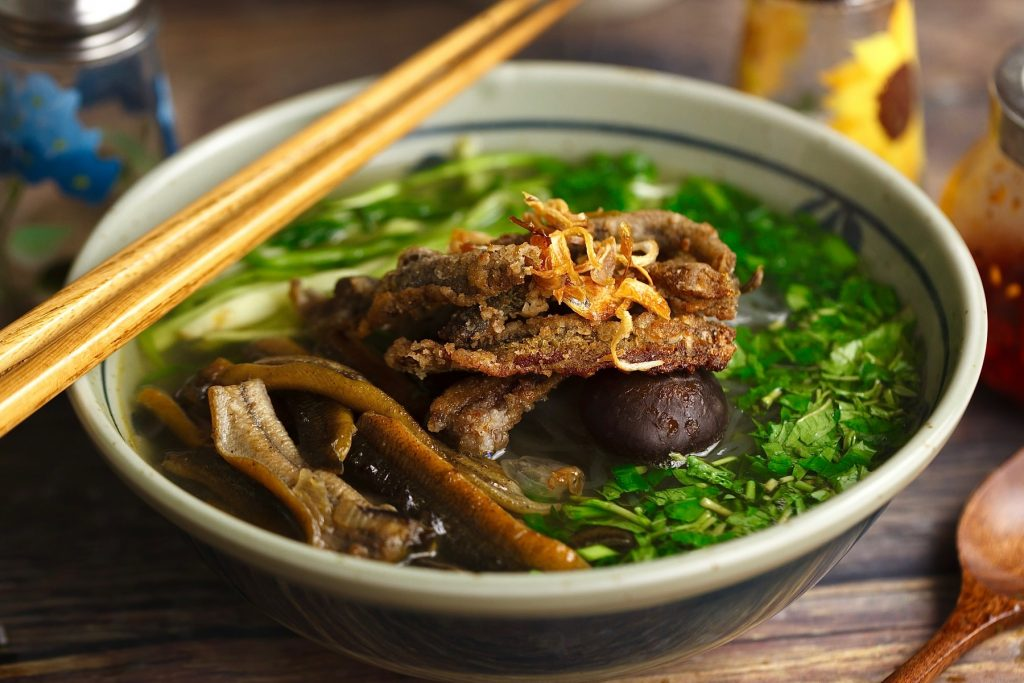
Cassava vermicellis are clear and sometimes referred to as ‘glass noodles’. The most unique part of this dish though is the selection of the biggest and freshest eels. They are carefully prepared and seasoned. Eel may sound like a strange meat but is actually similar to fish. Another key ingredient is the threads of freshly sliced banana flower. A portion of ginger and lemon juice are usually added to this soup for zing.
Local Dishes in Ninh Binh
| Raw goat meat with lemon (De tai chanh) | The tastiest goat meat is the stuff that hasn’t been cooked |
| Yen Mac Fermented Pork Roll (Nem chua Yen Mac) | The pork roll here is an impressive combination of flavours |
| Mountain Snails (Oc nui) | These mountain-dwelling snails are some of the toughest and tastiest around |
Raw Goat with Lemon (De tai chanh)

As previously mentioned, the goat meat in Ninh Binh is particularly tasty. It is said though, that it’s most delicious when it’s left raw The meat is sliced thinly with an even layer of skin and meat and simply mixed with a few different herbs and lemon. Like many other dishes in Vietnam, it also has its own special dipping sauce.
Fermented Pork Roll (Nem chua Yen Mac)
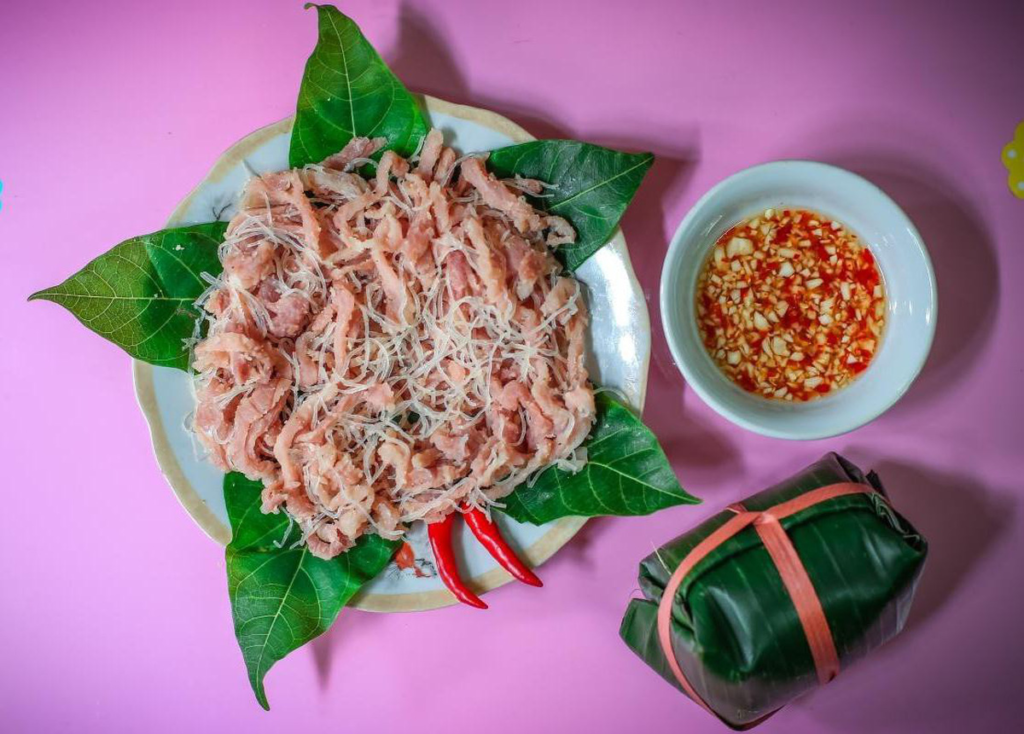
Yen Mac is a town in the mountains to the south of Ninh Binh proud of their unique fermented pork meat. Pork meat and skin are minced with other ingredients and spices and left to ferment in fig or guava leaves. It is usually shredded and served as a central dish on the table. The taste is a bizarrely sweet, sour, salty and garlicky blend and not always to everyone’s liking.
Mountain Snails (Oc Nui)
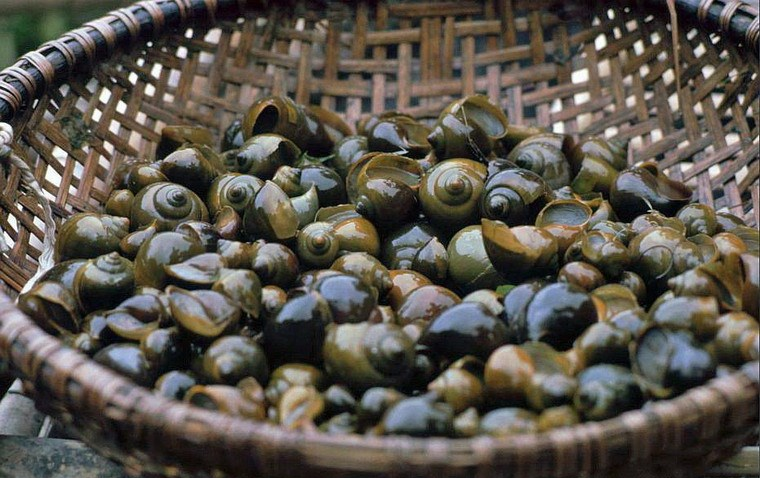
This kind of snail is unique to this region and only appear between April to August. They live on the limestone karts that surround Ninh Binh and survive on natural foliage. The meat is tough and depending on how they are prepared, can even be a little crunchy. The best way to have them is boiled and dipped in fish sauce.
Crazy Dishes in Ninh Binh
| Sticky rice with ants’ eggs (Xoi trung kien) | Sticky rice, fried onions and ant eggs are a great combination |
| Nhech fish salad (Kim Son salad) | A unique fish make for a wonderfully flavoursome dish |
Sticky rice with ants’ eggs (Xoi trung kien)

Sticky rice with ants eggs is a speciality unique to mountainous regions. It can’t just be any old ant though. It’s a specific variety of black ant that builds its nest in a tree. The process is quite sophisticated and all eggs are carefully collected and washed. Afterwards, they are mixed with onion and fried to bring out the wonderful taste.
Nhech fish salad (Kim Son salad)
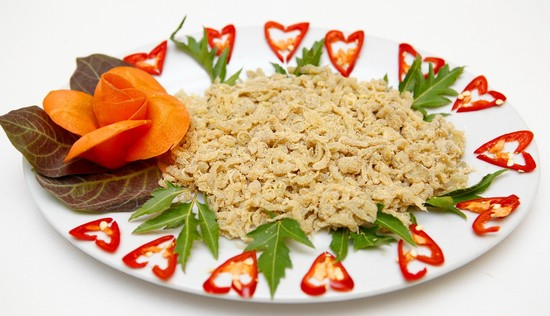
Nhech is a type of eel-like fish with relatively few bones and lots of meat. It makes for a very healthy dish which needs meticulous care from cooks to prepare. Your first impressions of the salad will be a vinegary taste matched by the spicy ginger and chilli and sourness of the lemongrass. The flavours are strong and not to everyone’s taste but it’s guaranteed to be truly memorable.
What to Eat in Hanoi
Easy food to eat in Hanoi
| Pho beef noodle soup (Pho Ha noi) | Tender beef and soft noodle in a salty and fulfilling soup |
| Grilled pork and noodles (Bun cha) | Grilled pork, noodles and a salty soup with fresh herbs |
| Mixed Noodle Soup (Bun Thang) | A classic and complex dish with a simple flavour |
Pho Noodle Soup (Pho Ha Noi)

Pho is an iconic Vietnamese dish you will find it available in almost every town across the nation. However, this dish originated in Hanoi and nowhere does it taste quite as good. The Pho in Hanoi is a little saltier than in the south and is richer in flavour. The noodles are flat and soft, the meat tender and the broth is a labour of love. It’s stewed all day long and can always be found nearby for breakfast, lunch or dinner.
Grilled Pork and Noodles (Bun cha)

This popular food from Hanoi was the dish that Anthony Bourdain and President Obama famously ate together. Grilled meatballs and slices of fatty pork are served with a salty soup with pickled vegetables. A plate of white rice noodles and leafy vegetables complete the meal. You eat the dish by combining a little of each ingredient in a small bowl and consuming that portion before repeating the process. It can be fiddly but the extra time means you can enjoy the delicious flavours that little bit longer.
Mixed Noodle Soup (Bun Thang)

This dish is unlike any other noodle soup and is named due to a large number of separate ingredients. Rice noodles, scrambled eggs, chicken, ham, small shrimps, pickles and mushrooms are added to the chicken and shrimp broth. This traditional Vietnamese dish is complicated to assemble but simple in taste and well-suited to western palates.
Local Dishes in Hanoi
| Fishball noodle soup (Cha ca la vong) | Noodles, coriander and something deliciously fishy is going on |
| Vermicelli noodles with fried tofu & shrimp paste (bun dau mam tom) | The tastes of tofu, cured meats and shrimp paste |
| Tomato and Crab Noodle Soup (Bun rieu cua) | A tangy and fragrant soup for warming up the insides |
Fish-ball Noodle Soup (Cha ca la vong)

This dish is one of the most unique in the nation’s capital and dates back to early colonial days. The fish used in this dish is a type of catfish found in the rivers of the northern mountains. Chunks of boneless fish are marinated in galangal and turmeric and lightly grilled before being fried and served with plenty of dill. The soup is served steaming-hot with rice noodles, peanuts, coriander and a tasty side sauce for dipping the bite-sized pieces of fish.
Noodles with Fried Tofu and Shrimp Paste (Bun dau mam tom)

Another popular dish in Hanoi which has grown into a national favourite. This is a food which is best shared with at least one other person. A platter is ordered with cold noodle cakes, tofu, other cuts of meat and fresh herbs and cucumber. These tasty morsels are then dipped into a side of pungent shrimp paste before devouring. If you’re not feeling so brave then choose a side of fish sauce instead. It’s fresh, simple and delicious eating at it’s best.
Tomato and Crab Noodle Soup (Bun rieu cua)

This is perhaps one of the most fragrant soups you’ll pass by on your time in Hanoi. This tangy tomato-based noodle soup is enhanced with the addition of freshwater crab meat, deep-fried tofu and is a Vietnamese favourite. You’ll also see dark brown cubes floating in this soup. It’s congealed pigs blood but don’t knock it till you’ve tried it. Served with a side of shredded banana leaf, bean sprouts and other herbs this dish packs a big flavour hit.
Crazy Dishes in Hanoi
| Blood Pudding (Tiet Canh) | A bowl full of blood, fish sauce, herbs and spices |
| Herb Infused Chicken Noodles(Ga Tan) | A healthy medicinal meal made with a unique black-bone silky hen |
| Ragworm cake (Cha ruoi ) | Pork mince and worm patties served with noodles and salad |
Blood Pudding (Tiet Canh)

Tiet Canh, unlike western blood pudding, is much more literal. The pig or duck’s blood is quickly mixed with fish sauce and salty water to prevent coagulation. Herbs, peanuts and occasionally the animal’s innards are added for extra flavour and ‘bite’. It is then set in the fridge to preserve its shape and freshness. If not, it can be quite dangerous to eat. It’s a dish only for the brave yet it tastes much better than it sounds.
Herb Infused Chicken Noodles (My Ga Tan)

There isn’t anything disgusting about this dish but it can catch the unsuspecting diner off guard. It greatly depends on what chicken you get. Order the black-bone silky and you may get a shock. Once you get over the tiny black chicken’s head popping up through the noodles though you’ll be fine. The soup contains a mixture of mugwort and other oriental herbs and is renowned for helping to cure the sick. The flavours in this wholesome and medicinal dish are one-of-a-kind.
Ragworm Cake (Cha ruoi)

These small and crispy cakes are a bit weird but worth the effort. The patties are prepared with pork, egg, dill and lemon rind before the worms, a dozen or so, are added. The fresh fritters are then fried and eaten with sides of rice noodles and leafy herbs. Like many other dishes in Vietnam, it also has a special dipping sauce.
What to Eat in Sapa and the Northern Highlands
Easy Food to Eat in Sapa and the Northern Highlands
| Free-range pig(Thit Lon Cap Nach ) | Probably the leanest and tastiest pork you will ever come across |
| Seven-color Sticky Rice (Xoi ngu sac) | The vibrant colours of this rice are hard to miss |
| Mustard Greens (Cai meo) | Simple vegetables unique to this region served in several ways |
Free-range Pig (Thit Lon Cap Nach)

Sapa’s greatest dish. One thing you will notice when in the highlands is that there are a lot more pigs running around. The variety is different too. They’re small and have low-hanging bellies. Due to their prevalence, pork meat is very popular and delicious. Their free-range nature makes the meat much leaner and tastier than sty-raised hogs. The name translates to ‘pig brought by armpit’ and refers to the way many buyers carry them back home.
Seven-color Sticky Rice (Xoi ngu sac)

This rice is a traditional dish in these parts to many ethnic groups in the area. The traditional seven colours seen are pink, light red, dark red, indigo, green, yellow and yellow-green. In reality, you may not see all these colours together. Sticky rice is much more glutenous than regular rice and more filling. It’s served at special events but is even served as a simple snack or breakfast dish.
Mustard Greens (Cai meo)

These vegetables are a staple in the northern mountains and often served with many different dishes. It’s usually stir-friend but can also be steamed or served with a hot pot. Other vegetables are often added to it, such as carrots or mushrooms, and when mixed with ginger it can make a tasty soup.
Local Dishes in Sapa and the Northern Highlands
| Corn porridge (men men) | Bland but versatile and fills the void for many locals |
| Rice and Pork congee (Chao Au ta) | A warming dish of rice porridge, pork and plant roots. |
| Corn cake soup (Banh duc ngo) | A simple yet fulfilling corn-based cake and sour soup |
Corn Flour (men men)

This bland yet common dish is made from ground corn flour and is a staple dish in the northern mountains. It has a somewhat nutty and greasy texture and is usually eaten with a side soup as it can become quite dry. In addition to that, it is also used in other dishes and many variations of this product are found.
Rice and Pork congee (Chao au ta)

This style of dish is popular across Vietnam but up here they use some extra special ingredients. Pork trotters, the root of the regions wolfsbane plant and a host of aromatic herbs gives this porridge a grey-ish colour and unique taste. Add an egg to the heat of this dish before eating and enjoy the warmth it provides.
Corn Cake Soup (Banh duc ngo)

This dish is common anywhere in the northern mountains however regional varieties exist. What first seems like big blocks of cheese are actually processed corn. The ‘cakes’ remain fairly bland in taste which is why they’re usually served in a sour soup. With added peanuts, sometimes pork mince and a stack of fresh herbs and you have a satisfying feed.
Crazy Dishes in Sapa and the Northern Highlands
| Horse Meat Soup (Thang Co) | A pungent yet traditional and tasty stew |
| Goat Intestine Stew (Nam Pia) | Even worse smelling and made from a concoction of beef/goats organs |
| Grilled Moss (Reu nuong) | A simple yet delicious natural snack. |
Horse Meat Soup (Thang co)

This soup is a traditional dish of the H’mong people and has a long history. Once reserved for special occasions, it has become more common due to tourism’s demands. It’s simmered for hours in a large pan, with the meat, bones and organs and a mix of special herbs and spices. The smell from this soup isn’t a pleasant experience but it’s surely a memorable one for those who’ve had a waft.
Goat Intestine Stew (Nam Pia)

This stew is yet another dish in this region that will challenge your nostrils and gag reflexes. This smelly dish is made from beef organs or sometimes goat. The smell is exaggerated by a side helping of paste taken from the lining of the cow’s intestines. Needless to say, few foreigners have been brave enough to try this one.
Grilled Moss (Reu nuong)

In comparison to the previous dishes this natural moss should be easy to stomach. The industrious people in this region have found a way to collect and use natural moss for sustenance. It can be fried or dried and eaten as a snack or as a side dish with a larger meal. At other times it’s simply added to a sauce for added flavouring. Often the best moss is found away from water sources and in the middle of the fields.
Vietnamese Desserts and Snacks
If you can’t tell by now let’s make it clear: Vietnamese love good food. It’s good news if you’ve got a sweet tooth too. Prepare to find a huge range of desserts, snacks, and cakes on your travels. If you need a little pick-me-up whilst traversing the country keep an eye out for some of these sweet and tasty treats.
Sweet Soup (Che)

This is the most common dessert you’ll come across during your time in Vietnam. It’s found almost anywhere from the roadside to some of the fanciest restaurants. There are several popular varieties based on beans, glutinous rice, corn or tapioca. The sweetness comes from the use of coconut milk, jellies or fruit such as banana and lychee. Sweet corn (che bap), three-colour soup (che ba mau), and banana che (che chuoi) are some of the most popular sweet soups.
Sesame Balls (Banh cam)

These balls of sweet and sticky goodness are often seen carried around the surrounding area of a local market. Filled with green, red or mung bean and shredded coconut they are then rolled in sesame seeds and lightly fried. Get more than one as they disappear quickly.
Creme Caramel (Banh flan/Banh caramen)

Inspired by the french, this sweet treat has become a favourite of young and old. The cake is based on egg and milk while the sauce is pure caramelised sugar. When done well the cake is incredibly smooth and creamy. Even when it’s done badly it still tastes so damn good.
Fried Banana (Chuoi chien)

I challenge you to find a better roadside treat than the humble fried banana. As the sun begins to set you’ll start seeing these stalls appear beside rural roadsides. A banana is cut in half, dipped in a thin batter and deep-fried in a large wok and left to cool on a display rack. It’s a cheap and tasty but not a particularly healthy way to increase your fruit intake.
Vietnamese Doughnut (Banh tieu)

At a similar time of day and only a few doors away from the fried banana is the Vietnamese doughnut stand. There’s no hole because it’s the inside of this tasty treat that’s full of air! These hand-sized pockets are warm, chewy, sweet and sprinkled with roasted sesame seeds.
Coconut Cakes (Banh bo)

These little mouthfuls of spongy goodness are unbelievably addictive. They’re soft and sweet and disappear way too fast. Made from flour, coconut, sugar, and yeast, they are subtle in flavour and often eaten with sesame seeds and coconut cream.
Black Sesame Soup (Che me den)

The blackness of this dessert may be off-putting but don’t be alarmed. This soup is served warm and not as flavoursome as some other desserts on this list. However, you’ll soon be won over by the rich and slightly woody and bitter flavours of the black sesame seeds and pennywort.
Pastry Cake (Banh pia)

These little puff pastry cakes originate on the Mekong Delta but can be found in many other parts. A standard cake is filled with a soft paste made from green bean and durian. The flavour of the durian is much weaker than normal and in no way is the smell as bad as the fruit. Inside the cake is a salted egg yolk which is dry and crumbly and a good contrast to the rest. Other flavours such as taro, coconut and mung bean can also be found.
Coconut Jelly (Rau cau trai dua)

This is not so easily found so make sure you take advantage of the opportunity when you can. Served in a coconut shell the top layer is smooth and creamy. Dig further down and you’ll find a layer of sweet jelly made from the coconut’s water. If you haven’t overdosed on coconut by the time you’re done then feel free to devour the flesh inside the shell.
Steamed Layer Cake (Banh da lon)

This traditional Vietnamese cake has a unique soft and chewy texture. It’s made from tapioca starch, rice flour, mung beans and coconut milk while coconut or taro are used for its subtle flavouring. To get the layering just right is important and takes a lot of skill and patience. The cakes can be steamed in several different shapes but there is no mistaking its colouring.
Vietnamese Drinks
Coffee (Ca phe)

Vietnam is the second-largest coffee producer in the world and famous for its rich iced coffee. Made with condensed milk rather than fresh, it’s already got that extra stimulant. No need for extra sugar or a double shot here. Iced coffee with milk is the default coffee in Vietnam. If you like your coffee black then let the waiter know. If you’d like your coffee hot then also make that clear. Most places in the country will serve coffee with ice unless specifically told otherwise.
Simple vocab to use when ordering coffee:
| English | Vietnamese | Pronunciation |
| Ice | Da | “Da” |
| Hot | Nong | “Nom” |
| Milk | Sua | “Sue-er” |
| Black | Den | “Den” |
- Iced milk coffee =“Ca phe sua da”
- Hot milk coffee=“Ca phe sua nong”
- Iced black coffee=“Ca phe den da”
- Hot black coffee=“Ca phe den nong”
Egg Coffee (Ca phe trung)

This creamy twist on a classic drop was developed over a century ago in a humble Hanoi cafe. It has now become synonymous with Vietnam. Vietnamese egg coffee is a smooth blend of coffee, sugar, condensed milk and egg yolks. It sounds a little weird but rest assured it’s amazing. Some keen drinkers are even confident enough to declare it as the ultimate coffee. I’ll let you be the judge of that for yourself.
Tea (Tra)

Tea is ubiquitous across Vietnam. In most cafe’s you’ll always be served a glass of tea with your coffee. To wash down your meal there’s almost always a jug of tea available at every restaurant. The flavour of most tea here isn’t as strong as you’d expect. Add a bit of ice and a little time and it can end up as little more than pale and off-tasting water. It’s not to everyone’s liking but it’s there.
Sugarcane Juice (Nuoc mia)

Sugarcane juice is mother nature’s energy drink and a favourite for those on the move. It’s usually served takeaway style in Vietnam and particularly helpful when you need to keep moving but want a quick boost. It’s not overly sweet and the glass is always loaded with plenty of ice. Crushed to a pulp before your eyes by two huge steel rollers. It just doesn’t get any more real than this.
Fresh Coconut (Dua tuoi)

Another all-natural beauty is found in the curvaceous form of a coconut. Slice the top off and you have the world’s most perfect juice and cup combo. After you’re done grab a spoon and scrape out the coconut flesh for a quick snack. A two-in-one package deal and completely biodegradable packaging. It’s cheap, delicious and a top drink choice in Vietnam.
Fruit Smoothie (Sinh to)

It’s no surprise that the land of fruit also provides some of the best smoothies you’ll ever have. There are dozens of banana varieties, the juiciest mangos and the sweetest pineapple. You can also find some other fruits like avocado, papaya or custard apple which may be harder to find at home. All smoothies are made with stacks of ice and a little condensed milk or sugar for sweetness.
Herbal Tea (Sam lanh)

There are dozens of herbal teas available in Vietnam but there are several varieties you will see for sale on the streets. Under the label ‘sam lanh’ you’ll find chilled teas made from a variety of ingredients such as daisy flower, mushrooms and other leaves. The drinks are smoky and bitter in flavour and often served from a chiller. Busier places will simply serve you on your bike allowing you to guzzle it down in a few gulps before continuing on your way.
Salty Lemon (Chanh muoi)

One drink that is often overlooked as a refreshing pick-me-up is the classic salty lemon. You’ll find this drink served in most cafe’s. Some places will simply serve you a few slices but the better places used preserved lemons or limes. After a teaspoon or two of salt, sugar, a heap of ice and a top up with water or club soda you’re guaranteed to be in lemon heaven.
Fruit in Vietnam
Vietnam is heaven for fruit lovers. It’s cheap, plentiful and super tasty. There is a wide variety of relatively standard fruits such as bananas, pineapples, oranges and watermelon. However, this list is focused instead on some of the more unique and favourite fruits in Vietnam.
Durian (Sau rieng)

Despite its reputation, durian remains a popular favourite and delicacy that’s generally regarded as a king of fruits. Despite a smell similar to a baby’s diaper, the flesh is incredibly tasty. Maybe this is one of the reasons for its extensive defence mechanism. It’s pretty expensive compared to other fruits, messy and will always remain one of those things you either love or hate. You’re only going to know once you try it!
Star Apple (Vu sua)

The name of this fruit translates to ‘breast milk’. When this fruit is ripe it is soft, supple and oozing with sweet white nectar. Little room is left to the imagination as to where it got its name from. Star apples don’t have a lot of pulp and simply cut in half and eaten with a spoon. This fruit is mainly found on the Mekong Delta and a little harder to find in other regions.
Longan (Nhan)

These bite-sized little pockets of nectar are nature’s perfect snack. These are a favourite fruit of many Vietnamese who love their delightful taste with just enough juice. Longan are easy to peel and the flesh slides easily off the large seed. You will usually find these for sale in large bunches by the side of the road and are a great travel snack.
Rambutan (Chom chom)

Another firm favourite and famous fruit from the Mekong Delta. I’m not sure if there is a category but rambutan are definitely in the running for the world’s cutest fruit. Their soft, spongy and somewhat furry shells serve a purpose to protect their beautifully sweet insides. This fruit is much less juicy than longan but just as popular and just as easy to take on the road.
Mangosteen (Mang cut)

Durian is the king of fruits in Vietnam and Mangosteen is regarded as its queen. The outside of mangosteen is quite hard and the delicate green petals almost make it look too good to eat. You can open these by squeezing them between your palms or simply slicing in half with a knife. The inside of the skin can give a somewhat sour tang to the fruit at times. Good mangosteen has stark white pulp and amazingly sweet flesh that seems to melt in your mouth.
Dragon Fruit (Thanh long)

Dragon fruit is yet another incredibly beautiful fruit in Vietnam and has become one of Vietnam’s biggest exported fruits over the past few years. There are two common varieties. They look identical and taste similar but one has white flesh while the other has red. To eat dragon fruit simply cut it in half and spoon out the flesh directly. It’s super sweet and a little juicy and a unique texture thanks to all the seeds. For the record, if you’ve ever had dragon fruit at home they taste much better here.
Guava (Oi)

Guava is a very popular and common snack in Vietnam. Its flesh is crunchy, the more it’s skin can be eaten and more or less resembles an apple. It’s not juicy though and the seeds are much smaller and spread out further from the centre. Guava is always prepared and cut before eating and often dipped in a salt and chilli powder to increase the sweetness.
Jackfruit (Mit)

This monster of a fruit is the world’s largest and resembles a durian but with much less harmful spikes. Ripe jackfruit can weigh up to three kilograms and you rarely buy the entire thing. Once opening a jackfruit you’ll see countless little segments perfect for a human hand to grasp. This fruit isn’t juicy but remains sweet and fragrant with stringy and sticky flesh.
Langsat (Bon bon)

This fruit is found growing from Vietnam’s central coast to the southern tip of the Mekong Delta. At first glance it may look like longan but are quite different. The skin can be easily peeled by hand, the flesh is segmented and the seeds are usually soft and small enough to eat. Langsat holds a special place in Vietnamese culture. As a Nguyen-era emperor hid out in the wilderness it is these little gifts which are credited with saving his life.
Java Apple (qua roi /qua man)

This little red bell-shaped fruit is a crunchy snack and juicy favourite of Vietnamese children. To eat these you usually break them open between your palms to make two halves. The texture of the inside can be rough and even a little powdering. These small apples should be washed thoroughly before being eaten paying close attention to the concave tops.
Common Vietnamese Food Myths
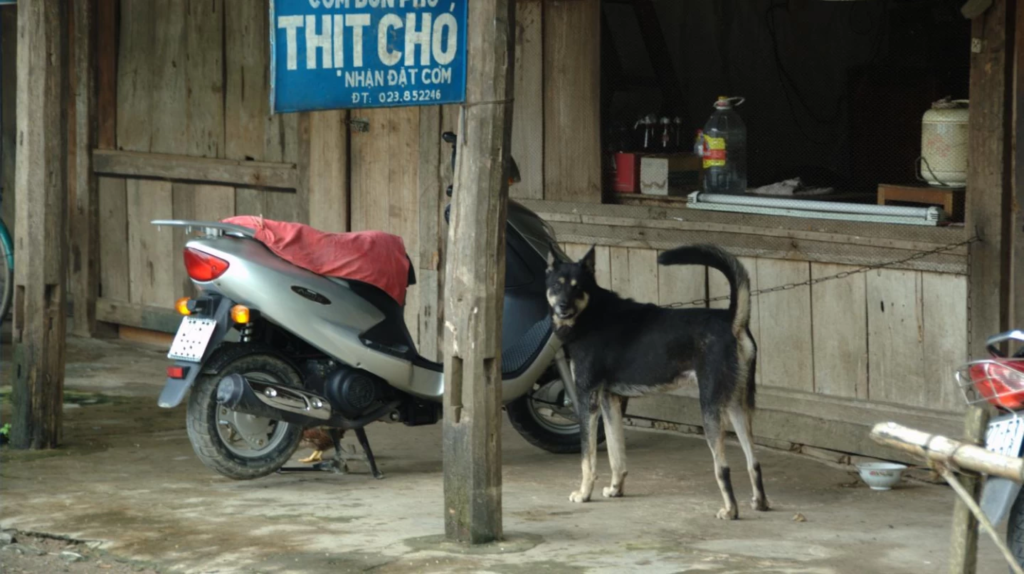
#1 Everyone eats dog and cat
No. This isn’t true. While dog and cat meat is eaten by some the vast majority of the population don’t. Dog meat restaurants are usually located well outside city centres and reserved for heavy drinking sessions.
#2 This weird meat on my plate is probably dog
Another common but false myth. Dog meat is actually quite expensive and it will never be used to replace a cheaper cut. Because of the meat’s high value, even pets are regularly stolen which means many Vietnamese look down on those who eat it.
#3 Street food is unsafe
As a general rule, it’s not unsafe but the most honest answer is “sometimes”. Most foreigners travelling in Vietnam won’t get seriously ill from street food. However, it’s usually easy to check out the kitchens and food here before you eat. If you see something you don’t like the look of then avoid it.
#4 Don’t drink the ice
Drinking ice is no problem in Vietnam. Some places may use tap while others use treated water. While some travellers avoid it, the locals and foreigners who don’t, rarely have issues from drinking ice.
#5 Coffee on the street is laced with chemicals
It’s true that some street sellers use chemicals to dilute or even as a substitute for coffee. It’s unsure how widespread the practice is but use price as a barometer. If you want to avoid the risk find a reputable cafe or even better, order a drip coffee (ca phe phin) and see it brewed in front of you.
Restaurants and Eateries: What to Expect
In the City

In the bigger cities and tourist areas expect to find a high variety of dining choices such as:
- Street food stalls
- Simple family-run restaurants (com binh dam, com tiem)
- Traditional beer and seafood places (quan nhau)
- Higher-end Vietnamese restaurants (nha hang)
- Food Courts
- Fast food
- International cuisine

The cheaper places are very basic but well equipped and cleaner than they may initially seem. Settle down on a small plastic stool and ignore the mess on the floor. Dogs and cats collect the bones and the napkins and other trash will be swept up at closing. In fact, after experiencing the convenience of low-down eating you may even feel it cumbersome when you go into a place with regular chairs.

Places which serve rice lunches are signified by large boards outside which state on them “com binh dan” or “com tiem”. The next step up is a “quan nhau” which usually have booklet menus and serve a range of dishes. These places are open-air eateries that are popular with drinkers and seafood lovers.

Larger and more expensive restaurants carry the name “nha hang”. These are more formal when compared to the last two types. They are usually enclosed, air-conditioned, have full-size tables and chairs and a cleaner environment.

In the Countryside
One thing for certain is that there will be fewer fancy restaurants and international foods than in the cities. The places you visit will be much more basic, there will be less choice and places will close earlier. Whereas some restaurants are open all day long in cities, rural areas will shut shop in the mid-morning and early afternoon. They’ll also close earlier at the end of the day too.
Another important thing to remember when eating in the countryside (or even in some cities) is that you’re a rare sight. In some remote spots, you may even be a once in a lifetime experience for the staff. Servers may be very shy, scared, overly friendly or a mixture of all three. Be aware of this and remember to embrace the moment and enjoy the experience.
Finding the best spots to eat in Vietnam

When choosing a place to eat make it less random. Below are a few tips on how local to find and decide on a good stall or restaurant with tasty food. Please note it’s only a guide and not a concrete set of rules.
- Learn some simple Vietnamese words for recognising food (see further down)
- Busy places – this is usually a good indicator that there is something special on offer.
- Language – learn to recognise basic words so you can tell what someone is selling as you are riding past.
- Children – Vietnamese have a theory that if young kids are eating there, it’s a good sign that the food is delicious.
- One Dish – “Jack-of-all-trades, master of none” rings true in Vietnamese culture too. If a shop can survive from selling one dish then they must be able to do it well.
- Approach the stall – see what they have on offer and don’t feel you’re being rude if you choose to leave.
- Check out Foody – a local app/website for visiting and rating restaurants. This is a reliable app which has reviews, addresses and maps of all the best places.
Vietnamese Eating Etiquette
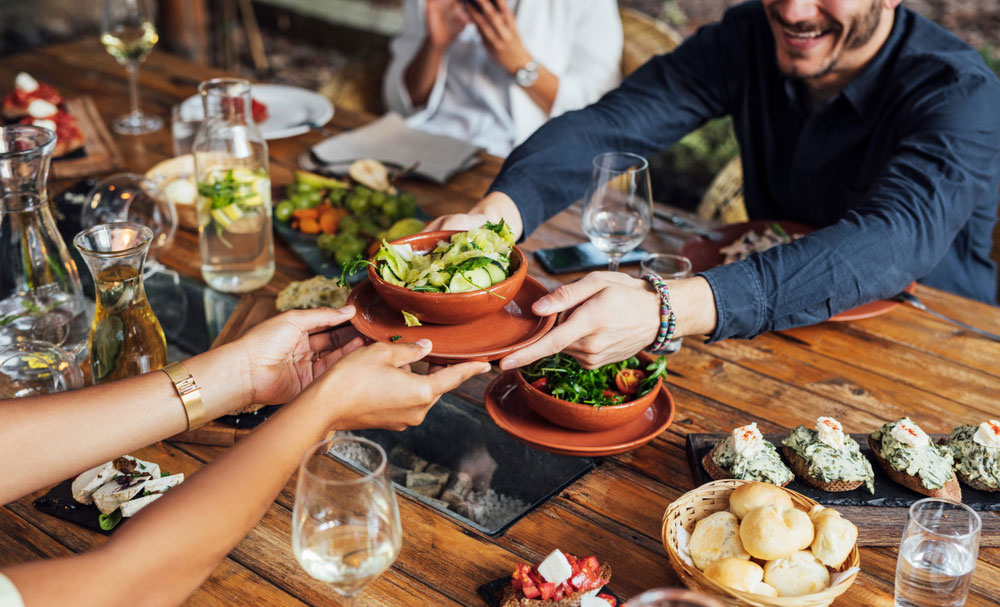
When travelling in Vietnam you’re going to spend a lot of time in public eating the scrumptious food. You’ll probably be lucky enough to get invited to a local’s table or even a family’s home. It’s important to be aware of some basic etiquette but don’t stress too much about it. It’s obvious that you’re a foreigner and you may not know local customs. You’re unlikely to offend if you get it wrong, but feel free to ask if unsure. Vietnamese love to share their culture.
- When welcoming a guest at home a fresh pot of tea will usually be brewed. A polite guest will accept it humbly and sip it slowly.
- Lay chopsticks across your bowl and never stand them up as they mimic incense sticks/death.
- Don’t joke around or play with your chopsticks.
- When eating shared dishes take the portion to your bowl before eating.
- Don’t pick through the food to get the best bit.
- Ask for a dish if you cannot reach it.
- Pass things with both hands
- Remove the bone instead of flipping the entire fish. It’s a bad omen for a sinking ship.
- Eat slow and enjoy the food and your company.
- Stay until others finish.
Alcohol and Drinking Culture

Between the years from 2005 to 2015, there was a 70% increase in Vietnam’s beer consumption. This unbelievable growth has catapulted Vietnam to become Asia’s third-largest alcohol consumer. This hike in beer consumption has also driven the rapid growth of the local brewing industry and it doesn’t seem to be slowing down. Regardless of where you happen to be, you’re bound to pass a party in your travels. You’re also going to be offered a drink… or two… or three. Drinking is a large part of social culture in Vietnam, particularly for men. However, it’s often known that most foreign girls also like a tipple and they’re also invited to join the fun.
Drinking Customs

- Sharing a beer or a shot glass of whiskey is a common way to connect with new friends. Often you’ll be greeted with a glass and motioned to down 50%.
- A few quiet beers is a rare thing in Vietnam. Vietnamese men drink to get drunk, merry and sometimes a little rowdy. Drinking is a great way to make new friends but if you don’t want much just let others know or take smaller sips.
- When drinking with a group always cheers before taking a sip. Raise a glass and invite the table to drink if you’re thirsty. It’s considered rude to drink or sip alone.
- When clinking glasses with elders make sure you show them respect by keeping the rim of your glass lower than theirs.
- Lastly, you will now learn how to say cheers. It will be a common cry you will hear on your Vietnam travels:

Drink Driving
There’s no way to sugar-coat this: drink driving and riding is a problem in Vietnam. Growth in alcohol consumption and a culture of independent travel and lax enforcement means that you need to be extra vigilant on the roads. You will often be able to see someone who is severely under the influence due to their riding style. Avoid them and let them pass. Drivers of cars are much harder to read. Sunday afternoons and evenings and public holidays see a spike in those wasted behind the wheel.

Beer
Vietnam has several large breweries such as Saigon, Huda and Bia Ha Noi. With many foreign brewers now controlling the local markets, Vietnamese brands and their own labels are becoming less popular. These days you’ll mostly see locals drinking popular ‘foreign’ lagers like Tiger, Heineken and Carlsberg. Ironically, most of these labels are brewed in Vietnam and don’t have the same taste as these beers do back home. Beer in Vietnam is cheap and readily available in Vietnam but there’s nothing special here apart from the recent emergence of a few craft beers.
One thing that is changing, particularly in Ha Noi and HCMC is the emergence of a craft beer scene. Expats and Vietnamese/Americans are credited with kickstarting the industry and many local talents are now making some very nice beers. Be warned, craft beer in Vietnam can sometimes come at a huge price premium over regular beers. To find one of these bars, a flavoursome beer and perhaps some serious western-style pub food, type “craft beer” into google maps. Wine Vietnam even has its own wine! Produced in Dalat, it uses grapes from nearby regions to help support the growing demand. The historical winery makes a red and white and it isn’t a bad drop. It’s worth noting that red wine is usually served chilled in Vietnam.

Whisky
When drinking local whisky in Vietnam it probably won’t be from barley or rye. Instead, you’ll need to get used to the sharp tang of banana or rice whiskey. Plum wine is another local specialty as well as certain kinds of rums. Most are of great standard or taste and there are always doubts over what ingredients are used in the process. Snakes, scorpions and lizards in your bottle are optional. Each animal serves some kind of purpose for enhancing the consumer’s health. Most of the time it’s all about giving a man a longer and harder… sense of confidence.
Tips on Avoiding Sickness

Food in Vietnam, even street food, is safe to eat. While it’s rare to get seriously ill from the food here, there may be some precautions to take:
- Avoid uncooked vegetables – cooked foods have any chemical residue or bacteria washed off or killed.
- Hot soup – Make sure when served soup that it is steaming hot. If the soup is unlikely to burn your tongue once it arrives then ask for a fresh one.
- Eat at busy places – high turnover assumes that the food is sold relatively quickly. Also, try to eat at regular mealtimes when the food is freshest.
- Don’t drink the tap water – However, it can be safely used to bathe and brush your teeth with.
- Stay well hydrated – it’s easy to forget how much fluid you sweat out when riding in the tropics.
- Wash your hands before using hands – This rule applies everywhere but here is particularly important here as soap and washing facilities are not always easy to access.
- Clean your cutlery – use a napkin to remove any contaminants before you eat. If you’re feeling keen you can even use the cut lime on the table to sterilise your chopsticks!
Food and Drink Vietnamese: What to say when ordering

Vietnamese isn’t an easy language to learn and most foreigners find it incredibly difficult to pronounce. The best thing is that it is readable and by the end of your trip you will probably be able to recognise some words. This section will introduce a handful of Vietnamese words and phrases which may come in handy when eating your way across the country. Remember that:
- All Vietnamese words are ONE syllable,
- The tone is important but hard to master,
- Read, write and practice along the way,
- Body language will be the best communication tool.
Helpful Vietnamese Words When Hungry
| English | Vietnamese | Pronunciation |
| Eat | An | An |
| Meat | Thịt | Tit |
| Vegetables | Rau | Raow |
| Fruit | Trái cây | Tray kay |
| Beef | Bò | Baw |
| Chicken | Gà | Ga |
| Fish | Cá | Ca |
| Chips | Khoai tay chien | Kway tay chin |
| Rice Noodles | Bun, pho, hu tieu | Bun, fer, who tiew |
| Egg Noodles | Mi | Me |
| Fried (Noodles) | xao | Sauw |
| Rice | Com | Kerm |
| Fried (Rice) | Chien | Chin |
| Cake/Cookie | Banh | Ban |
| Ice Cream | Kem | Kem |
| Delicious | Ngon | Ngon |
Helpful Vietnamese Words When Thirsty
| English | Vietnamese | Pronunciation |
| Water | Nuoc Suoi | Nerc suwi |
| Juice | Nuoc Ep | Nerc ep |
| Smoothie | Sinh To | Sin toe |
| Iced black coffee | Cà phê đen đá | Ca fay den da |
| Iced coffee with milk | Cà phê sữa đá | Ca fey sue-er da |
| Filter coffee | Cà phê phin | Ca fey fin |
| Iced tea | Trà đá | Tra dar |
| Milk Tea | Trà sữa | Tra sue-er |
| Beer | Bia | Bia |
| Hot | Nong | Nom |
| Cold | Lanh | Lan |
| Ice | Da | Da |
| Sugar | Duong | Doong |
Where to Eat or Drink
| English | Vietnamese | Pronunciation |
| Cheap rice lunch | Com binh dan, Com tiem | Kerm bin yern, Kerm diem |
| Beer and Seafood (open air) | Quan nhau | Kwan nyaw |
| Restaurant | Nha Hang | Nya hang |
| Drink shop | Giai khat | Yay cat |
Some Useful Phrases
| English | Vietnamese | Pronunciation |
| Give me this please (and point) | Cho toi cai nay | Cho toy cay nay |
| I’m hungry | Toi doi | Toi doi |
| I’m thirsty | Toi khat | Toi cat |
| I like | Toi thich | Toi tick |
| I don’t like | Toi khong thich | Toi kom tick |
| How much money? | Bao nhieu tien? | Baow nyew teen? |
| Where is the toilet? | Toa let o dau? | Toi let er daow? |
Counting to Ten in Vietnamese
| English | Vietnamese | Pronunciation |
| One | Mot | Mop |
| Two | Hai | Hi |
| Three | Ba | Bah |
| Four | Bon | Bom |
| Five | Nam | Nam |
| Six | Sau | Sao |
| Seven | Bay | Bay |
| Eight | Tam | Tahm |
| Nine | Chin | Cheen |
| Ten | Muoi | Muei |
